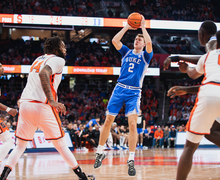2 SU students create FibreFree to make laundry more sustainable
Kai Nguyen | Photo Editor
SU students Charles Keppler and Serena Omo-Lamai are taking their invention to Albany later this month to compete in the New York Business Plan Competition.
Charles Keppler was browsing through the app Curiosity Makes You Smarter, which sends users information on five new topics every day, when he came across an article on microfibers. According to findings from ecologist Mark Browne, 85 percent of human-made pollution found on shorelines comes from the polyester and acrylics used in clothing.
During the six-week Invent@SU Invention Accelerator program last summer, Keppler and Serena Omo-Lamai created a device to try and combat that statistic. FibreFree, a microfiber trapping device resembling a laundry ball, features a porous shell with a recyclable filter on the inside. The filter consists of dense, interlaced strands that lodge microfibers while allowing free flow of water and heat.
Keppler and Omo-Lamai, both students at Syracuse University, will travel to Albany with 11 other SU student venture teams to present FibreFree at the ninth annual New York Business Plan Competition on April 27. Their invention will compete for the grand prize in the Clean Technology category.
Preliminary testing done by the duo showed that the laundry ball catches about 40 percent of the microfibers shed from synthetic clothing fabrics. The filter is made up entirely of recyclable and replaceable polyethylene and can filter fibers down to one micrometer. FibreFree eliminates the need for washer balls, dryer balls and dryer sheets.

Courtesy of Charles Keppler and Serena Omo-Lamai
Keppler, a senior studying aerospace engineering, physics and applied mathematics, and Omo-Lamai, a sophomore bioengineering major, met during Invent@SU. Their first idea was to place a filter at the back of the washing machine with the drain to trap microfibers. However, after consulting with a General Electric representative judging the program, the solution was found to be unfeasible as the filter could void the machine’s warranty and disrupt water flow.
Moving on to the laundry ball idea, their first 3-D-printed prototype was football-shaped and collected nothing, Keppler said. They went through four or five design sketches, trying to incorporate concepts from other designs on the market. They refined effective features from other products to arrive at the current version of FibreFree. Omo-Lamai said one of the things she learned the most was tenacity and being able to follow through with an idea.
“It’s an approach to problem-solving as opposed to a body of knowledge about solving problems,” Keppler said.
He also added that the duo shared a complete lack of business knowledge as they ventured into student startups. They received help from the Science and Technology Center at the College of Law and the Blackstone LaunchPad.
Linda Hartsock, executive director of SU’s Blackstone LaunchPad, reached out to Keppler and Omo-Lamai last summer when she saw FibreFree’s potential to turn into a business venture. Hartsock said the best ventures are cross-disciplinary, and that any invention without a path to market “is just a good idea.”
To commercialize FibreFree, Keppler and Omo-Lamai had to learn a variety of legal and business knowledge such as license strategy, economic models, fixed and variable costs and operating budget, Hartsock said.
“You have to balance all of your responsibilities while also trying to learn this entire other field of operations,” Keppler said.
Their next step is to secure seed money to pay for independent third-party testing that will validate FibreFree’s function. They will also need to re-submit the provisional patent application before it expires in June.
FibreFree has won funds from the RvD iPrize at the School of Information Studies and the Impact Prize competition at the Blackstone LaunchPad. The invention also placed in the International Top 20 for the James Dyson Award last year.
Published on April 16, 2018 at 10:33 pm
Contact Jiaman: jpeng04@syr.edu






